Terebess
gyümölcskalauz
«
vissza a Terebess Online nyitólapjára
«
vissza a Kertek
és konyhák indexlapra
«
vissza a Terebess-kert főlapjára
Nashi,
a japán körte
Pyrus pyrifolia
A nálunk termesztett körtefajtákat európai szülőkből nemesítették ki. Jellemzőjük, hogy rendszerint nagy méretűek, jellegzetes körte alakúak, bőlevűek, olvadó húsúak. A kelet-ázsiai fajták csak most kezdenek hazánkban elterjedni, bár Ázsiában már több mint 3000 éve termesztettek. Ezek inkább alma alakúak, kisebb méretűek, illatosak, kevésbé bőlevűek, fájuk sokkal ellenállóbb és igénytelenebb. A teljes érés előtt pár héttel leszedve hűtőházban februárig, házikertben decemberig jól tárolhatók. Három fajtája kapható nálunk, a Kosui, a Hosui és a Nijisseiki.
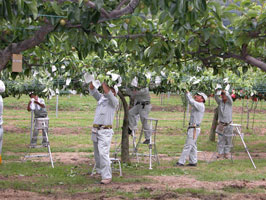
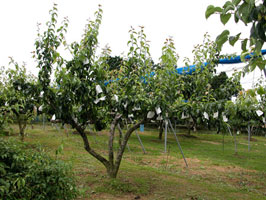
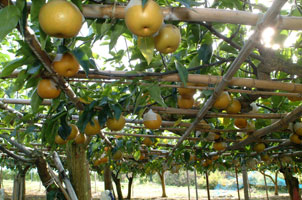
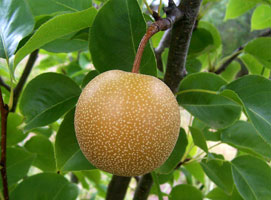
Nashi or Asian
pears are totally different to the European pear, Pyrus communi. The Nashi are
either Pyrus pyrifolia, P. bretschneideri or P. ussuriensis. They originate from
eastern Asia, China, Japan and Korea. Most are compatible when grafted on each
other, and will mostly cross-pollinate each other, if the flowering time is the
same. Nashi are a popular fruit with most Asian cultures, being extremely juicy
but having a fairly bland flavour. They are used more as thirst quenchers rather
than as a means of satisfying hunger. In addition to being popular as a fruit,
they have some useful characteristics of shape and disease resistance. Nashi are
used in pear variety breeding programs to develop more interesting pears.
There
are 3 types of Asian pears. They are (1) round or flat fruit with green-to-yellow
skin, (2) round or flat fruit with bronze-colored skin and a light bronze-russet
(3) pear-shaped fruit with green or russet skin.
http://kertpont.hu/cikknyomtathato.php3?cikkid=38
http://www.sedi-fruits.at/valasztek/nashi
http://www.agraria.org/coltivazioniarboree/nashi.htm
http://www.agric.nsw.gov.au/reader/pome-fruits/h4114intr.htm
http://www.tenkoen.co.jp/product/nashi/index.htm
http://www.tnt.jp/%7Eishido/nashi.html
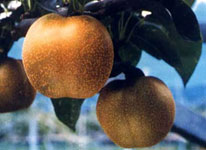
Akiakari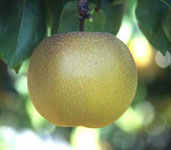
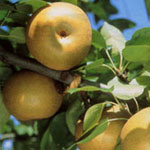
Akizuki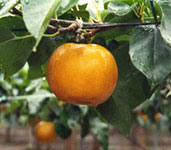
Syusui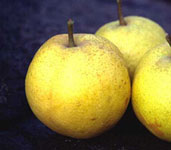
Hokusin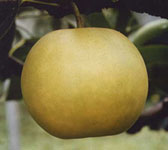
Seiki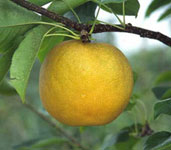
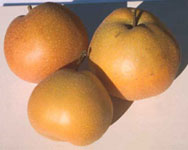
Nidaka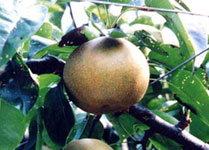
Hougetu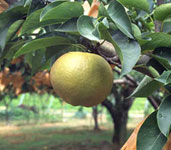
Atago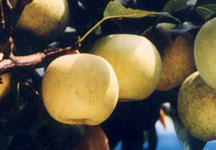
Syurei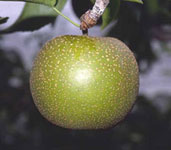
Tikusui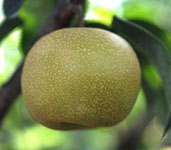
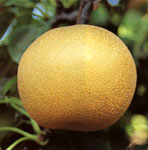
'Kosui' (Japan, 1959; the
most important cultivar in Japan)
A Kosui augusztus közepétől szedhető, szeptember
elejétől fogyasztható, középnagy gyümölcsű, barnásparás héjjal. Édes, illatos
húsú. Fája középerős növekedésű, szeles helyen kissé törékeny. Igen korán termőre
fordul. Jó pollenadója a Hosuinak és a Nijisseikinek.
'Kousui': A small, flat
bronze-russet early-maturing, sweet fruit with a tender skin that ripens in mid-July.
A strong-growing tree with leaves sensitive to 2-spot spider mites and many sprays.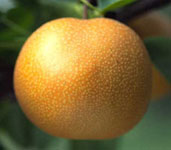
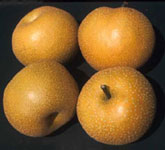
'Housui' (Japan, 1972)
A
Hosui a Kosuinál egy héttel később szedhető, nagy gyümölcsű, aranybronzos színű,
olvadó, lédús, nagyon illatos és zamatos, kissé savas. Meleg, napos helyre ültessük,
mert árnyékos helyen vagy hűvös nyáron kevéssé lesz édes. Fája kicsit nagyobb
a Kosuiénál.
'Hosui': A very large, juicy, sweet, low acid, bronze-skinned
pear that ripens in early August. The tree is extremely vigorous on P. betulaefolia
and has a wild, loose growth habit. This is a very popular new cultivar in Japan
and California. It gives good consumer and grower satisfaction. It is usually
very susceptible to fireblight and stores for four to six weeks.
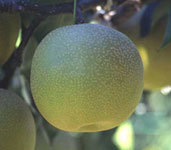
Sinsei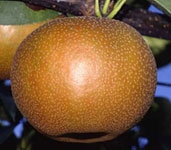
Nansui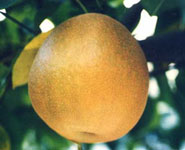
Ousyu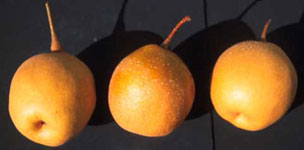
Bong
Ri 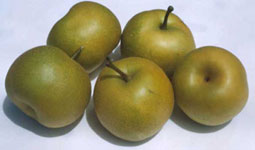
Choju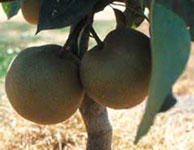
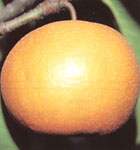
'Chojuro' (Japán, 1890-es
évek)
An old, firm, brown- to orange-skinned, flat-shaped, highly productive
cultivar is losing popularity because it is not as juicy as many newer ones. It
matures in mid-August, bruises easily but stores for five months. It must be picked
when first yellow-brown in color or fruit is subject to severe bruising and skin
discoloration.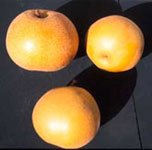
'Danbae'
(Korea, 1969; also known as 'Arirang', 'Korean Giant', 'Olympic') 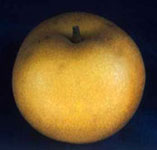
Haeng
So 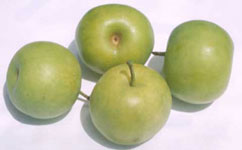
Hakko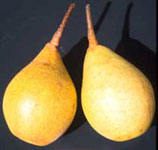
Hwa
Hong 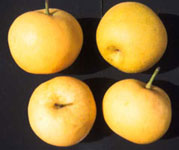
'Kikusui': A
flat, yellow-green, medium-sized fruit with excellent flavor but a reputation
for having, tender skin. The fruit stores well until February but the dull-colored
skin makes it less attractive at harvest than '20th Century'. The fruit sizes
better and has flavor and texture equal to '20th Century'. It ripens in mid-August
but fruit has preharvest drop problems. Tree has average vigor.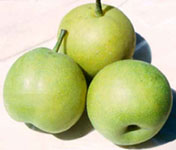
A
Nijisseiki szeptember elejétől szedhető, igen bőtermő fajta. Gyümölcse sárgászöld,
sima héjú, közepes méretű. Ropogós, de bőlevű, édeskés, illatos, zamatos. Fája
szintén erős növekedésű és korán termőre forduló. Már a második évben terem, de
ekkor célszerű a virágokat eltávolítani, mert különben leszakadhatnak az ágak.
Igen bőtermő ezért célszerű rendszeresen ritkítani.
'Nijisseiki' (Japan, 1898;
name means "20th century", also spelled 'Nijusseiki')
'20th Century'
('Nijisseki'): This is the best flavored and most popular Asian pear in Japan
and California. It originated in Japan in about 1900 and was responsible for the
high popularity of pears in Japan. It is round, yellow-skinned, easily bruised,
but stores well up to six months. The fruit is more difficult to size than other
cultivars but its popularity outweighs this problem. It should not be grown on
P. communis rootstock because it is severely dwarfed. The fruit ripens in mid-August.
It grows well on P. betulaefolia, P. calleryana, and P. serotina. Old trees need
spur removal and rejuvenating pruning to maintain fruit size. The tree is naturally
well shaped and easy to handle. 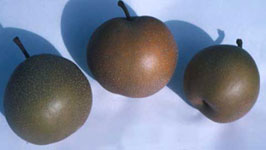
Okusanki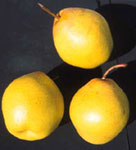
Shen-Li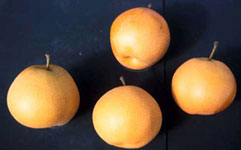
Shin
Go 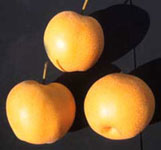
'Shinko': The fruit
is large and round to slightly flattened with a beautiful bronze-russet skin.
Fruit flavor is excellent in hot climates but the fruit stores only about two
months. The tree is well shaped and extremely productive, an annual bearer despite
heavy crops. It matures during the first week of September and appears to be nearly
resistant to fireblight.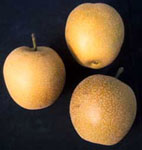
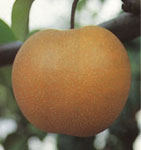
Shinsei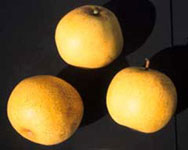
'Shinseiki'
(Japan, 1945; name means "New century")
A round, yellow-skinned,
firm fruit that is early-maturing (late July) plus it stores well up to three
months. In appearance it resembles '20th Century' but is less flavorful. Trees
are self-fruitful in the San Joaquin Valley. They require no pollinators. Fruit
holds on the tree well and is often color-picked four times per season. Heavy
thinning is necessary for good fruit size. 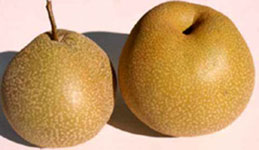
Shinsetsu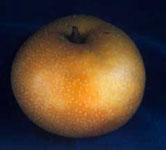
Shin
Soo 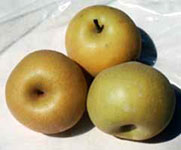
'Shinsui': An
early-maturing, brown fruit with reasonable size, ripening in mid-July after 'Ichiban
Nashi' and before 'Shinseiki'.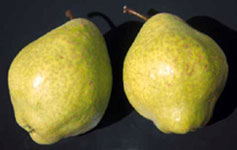
'Tsu
Li': A large, football-shaped, green fruit of only fair quality. It has long storage
life (six to ten months) and gets better the longer it is stored. The fruit ripens
in early to mid-September and develops a greasy feel on the skin. It must be pollinated
by 'Ya Li'. 'Tsu Li' in California and 'Tsu Li' in China are not the same cultivar.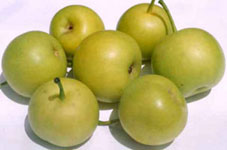
Yakumo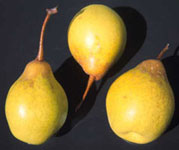
'Ya
Li': A popular Chinese cultivar, is pear-shaped, has green skin and is quite tender
to bruising. It is early blooming and requires cross-pollination by other early
flowering cultivars such as 'Tsu Li' and 'Seuri'. The flavor is sweet and milder
than other cultivars. When properly thinned and pollinated it sizes to 10 to 12
ounces. It is the most important pear cultivar in China. It stores well until
February and keeps its green color. Trees are very productive and vigorous on
all pear rootstocks. It ripens late in August and early September. This cultivar
is slower to come into production than most Japanese cultivars.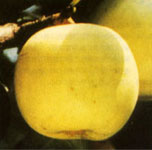
Shurei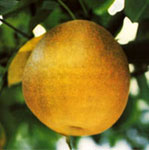
Ohshu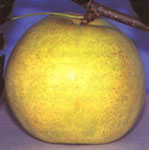
Kaori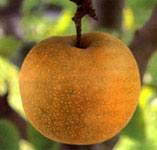
Chikusui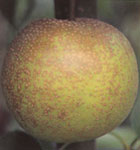
Tama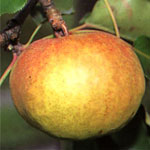
Enju
További fajták:
'Seigyoku' (Japan)
'Ichiban Nashi': An early-maturing, large, brown fruit ripening in mid-July ahead of 'Shinseiki', 'Shinsui' and 'Kosui.''Yoinashi': A large, brown-skinned fruit with excellent flavor. It ripens in mid-August with '20th Century' but sizes much better.
'Niitaka' (Japan, 1927)
'Niitaka': A very large, firm, brown-russet fruit. It is noted for its large size, average flavor and high production. The tree is dwarfed severely on P. communis and vigorous on P. betulaefolia. Fruit ripens in early September and stores two months. The flowers are pollen-sterile but it sets well when cross-pollinated with most varieties.'Dasui Li' and 'Shin Li': New U.C. hybrids, very large fruit, greenish to yellow in color. They ripen in late September and early October and store well at 32°F for six months. Trees are extremely vigorous and pollinate each other. For good crops, limited pruning is essential in the second and third seasons to slow growth and encourage spur and fruit production. They grow well on P. betulaefolia or P. communis roots.
'Okusankichi': This is an old Korean and Japanese cultivar that ripens in October and stores well. The fruit is brown-russet, somewhat elongated and slightly irregular in shape. At harvest it has only fair flavor, but flavor improves in storage.
Japán
körte - Nasi
A
"nasi" Japánban termesztett körtét jelent, más országokban ezt a gyümölcsöt
különböző nevekkel illetik, pl. vízikörte, ázsiai körte, almakörte, körtealma
...
Több tulajdonságban is eltér az európai körtétől. Nemcsak a gyümölcs alakja,
színe, beltartalmi értékei térnek el, hanem az érési típusa is.
A nasi gyümölcsei
fán beérők, a fogyasztási érettség eléréséhez még a késői érésű fajtáknál sincs
szükség utóérlelésre.
A japán körték gyümölcse szilárd, mégis ropogós és lédús
(85-86 %-a víz).
Kevesebb energiát tartalmaz, mint az alma vagy a körte. Ugyanakkor
magas a cellulóz-, hemicelluóz- és pektintartalma, ezért táplálkozásbiológiai
szempontból nagyon előnyös.
A körtefajtákhoz hasonlóan a nasifajták idegen
megporzást igényelnek, ezért telepítéskor 2 esetleg 3 fajtát kell együtt ültetni.
Japánban a túlkötődés miatt a legtöbb fajtát kézzel ritkítják, csak így érik el
a megfelelő méretet.
A gyümölcsök tömege az eredeti termőhelyen, ritkítás
mellett 200-450 gr is lehet. Olaszországban azonban még a nagy gyümölcsű fajták
tömege is csak 250 gr.
Ízükkel kapcsolatban megoszlanak a vélemények, zamatuk
leginkább a sárgadinnyére, birsre és az ananászra emlékeztet.
Japánban a nasifajták
gyümölcsminősége iránti igények igen magasak (100 mm átmérő ás szabályos gömb
alak). Szinte kizárólag úgy termesztik, hogy egyenként bezacskózva védik a madárkártételtől.
Magyarországon ennél kisebbek a gyümölcsök, de jó termőhelyen, intenzív körülmények
között elérhetik a 150-250 gr-ot.
A gyümölcs húsa fehér-fehéressárga, rendkívűl
illatos, lédús.
Hosui
Japán
egyik fő fajtája s Európában ez a fajta a legerterjedtebb.
Középidőben érik,
augusztus harmadik és negyedik hetében szedhető.
Gyümölcse középnagy (150-200
gr) közepesen vastag héjú, színe egységesen aranybronzos, tetszetős, nagy lenticellákkal
borított. A gyümölcshús roppanó, lédús, kissé savas. 2-3 hónapig tárolható.
Fája erős növekedésű, felfelé törő koronát nevel.
A fiatal, 2-3 éves termőgallyakon
terem, ezért az idősebb termőgallyakat ifjítani kell.
Korán termőre fordul,
termőképessége jó.
Nijisseiki
Középidőben,
augusztus végén lehet kezdeni a szüretet. Több menetben kell szedni.
A gyümölcs
nagysága elérheti a 200-250 gr-ot, de ritkítás nélkül csak 50-80 gr, mert csaknem
minden virágból gyümölcs kötődik.
A héj vékony, sima, zöld, majd sárga.
4-5 hónapig is jól tárolható +1 °C hőmérsékleten.
Fája középerős vagy gyenge
növekedésű.
Igen korán termőre fordul, már a második évben nagy termésre hajlamos.
Az első virágzatok nagy részét el kell távolítani, mert szétszakadhatnak a fák
(hazai tapasztalat).